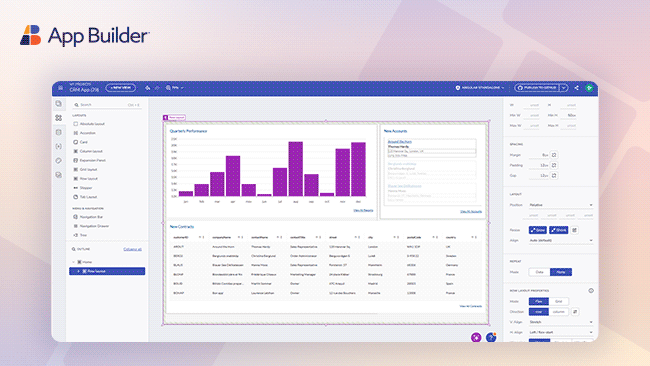

Empowering Citizen Developers: A CTO’s Guide To Leveraging Non-Technical Talent
C-level executives are trying to navigate between the need for rapid innovation and the resource constraints of their overstretched IT departments. Are citizen developers the solution to this and other major bottlenecks? And can low-code app development empower them and increase business agility? Read here.
For some businesses, it’s the era of citizen developers and automation. According to Forrester, ”the democratization of development to workers outside of IT shows no signs of slowing down — and as citizen developer strategies mature, we believe that this relatively untapped use case will sustain a 21% growth rate for the next five years, growing to approximately $30 billion in 2028.” But what’s causing this trend in software development?
IT teams often hit roadblocks as they must tackle overloaded workflows, manage backlogs, and are stretched thin across multiple projects at the same time. This frequently leads to certain drawbacks for the business such as delayed deployments and slow time to market. As it stands, not having enough human capacity and resources prevents companies from keeping up with industry demands, makes it more difficult for teams to handle the growing number of requests daily, and limits the number of potential business growth initiatives.
So, C-level executives are trying to navigate between the need for rapid innovation and the resource constraints of their overstretched IT departments. Are citizen developers the solution to this and other major bottlenecks? And can low-code app development empower them, increase business agility, and reduce the pressure on IT in general with the use of citizen development platforms?
This article will provide the answers.
What Is Citizen Development?
Citizen development is a business practice that enables business users to build enterprise-grade applications autonomously without involving the IT team. To do that in the most efficient way while still complying with industry standards and without compromising quality or security, citizen developers typically use low-code tools like App Builder.
A necessary clarification that Gartner makes is that “all citizen developers are business technologists. However, not all business technologists are necessarily citizen developers. There is no required designation of proficiency or time allocation for citizen developers, but they must be legal employees of an organization.”
Benefits of Citizen Development
Nowadays, the supply-demand gap is growing and C-suite executives’ priorities have changed to address this challenge. Solutions are expected to be built faster; teams are expected to work more productively while juggling between adapting to digital transformation technologies and business goals. With these dynamics in mind, CTOs, CIOs, and other executives are now switching from traditional development to low code, which is more agile. They can no longer afford to limit their options to experienced developers only.
Suppose your company, for example, needs to update a product with a new app functionality. In that case, you should see if the IT team has the resources (availability and the right tool in their tech stack) to complete it as fast as possible. Nevertheless, when resources are limited, citizen development provides various benefits and streamlines the process. This way, your business doesn’t lose money from prolonged development cycles or IT workforce reallocation.
Instead, it translates into measurable beneficial results for the company with real business impacts like:
- Faster time to market and cleared backlogs
- Increased productivity and reduced need for IT intervention using low code
- Streamlined development cycles with task automation
- Adapting to markets quicker with ideas that are tested in days
- Higher employee engagement and better workflows
- More agile businesses that can easily respond to changing market conditions
- Fewer costs by making use of resources in-house
- Innovation because you involve more people and expand through ideas
- Tangible business value, like new revenue streams from creative solutions
- Moving away from fusion teams to assisted development
Citizen Developer vs Professional Developer
In many ways, citizen development is a force-multiplier that blurs the boundaries between IT and business. It becomes a leverage point without the need for substantial additional investment in software developers. Instead, you expand your talent pool to have access to non-technical users. You go much broader and allow more people to innovate and experiment with new perspectives using automation tools.
At the same time, this creates a cultural shift, where the business now benefits from an assisted development area. The IT team still has control over governance and security, but the process becomes more collaborative, allowing more innovation, flexibility, and agility when citizen developers take charge too. It’s a balance of power shifts.
The offload of routine tasks to non-technical talent allows more experienced programmers and software engineers to prioritize strategic initiatives that align with their expertise. But what tasks go where?
On the one hand, citizen developers are responsible for:
- Rapid prototyping
- Data transfers between apps
- Modifying user interfaces of existing apps
- Design forms
- Creating data visualization dashboards and more
On the other hand, experienced developers are focusing on:
- Developing mission-critical or data-heavy applications
- Integrating advanced technologies like AI
- Optimizing existing systems for better performance
- Managing access to sensitive data
- Making sure proper security configurations are set for the app, etc.
How Does Low Code Empower Citizen Developers?

There are different ways to solidify the skills of citizen developers to achieve business goals and maximum workforce potential. This goes from selecting the most appropriate platforms to sharing common visions. But let’s explore each.
Step 1: Equip them with the right citizen development platforms
Your teams need to work more efficiently to deliver the results that users and the industry demand. At the same time, you need to make sure that well-established internal business operations remain intact despite the changes. One of the ways that has been proven to work flawlessly is the implementation of low-code tools. In the hands of businesses with limited resources, then, they become accelerators of results that improve developer productivity and timelines.
Typically, low-code platforms are easy to integrate with existing systems without causing disruptions. On the contrary. Tools like App Builder offer intuitive, drag-and-drop visual development interfaces that enable users to design and build new projects quickly.
The most significant advantage here is that they work as citizen developer platforms, enabling teams to work together optimally, covering everything from ideation and design to code. There are reusable UI components, plus features like instant code generation for popular web frameworks, real-time code preview, test functionalities, AI-driven capabilities like image generation or data source generation, and more. Stakeholders can quickly gather feedback as well, accelerating iteration cycles and refinements.
Step 2: Bridge the gap between IT and business values
It’s not enough to simply give non-technical users innovative visual tools to build highly functional business applications. Another step towards empowering citizen developers is to ensure they know each process involved in driving business growth, each tool used to maximize efficiency and optimize specific tasks, and why and how their contributions fit into the overall organizational strategy.
Step 3: Create and maintain a Center of Excellence (CoE)
As citizen developers will be involved in more projects and tasks, providing training and communicating every aspect of the app or the development process is key. Dedicate some time to ongoing learning opportunities that respond to the specific needs of citizen developers. Implement strategies that foster collaborative work. This helps gauge the effectiveness of citizen development, letting them seamlessly adopt any platform and more technical process.
Step 4: Take proactive measures to eliminate pitfalls
Although citizen developers work autonomously, without proper oversight and control, they could expose your organization to significant risks. Introduce guidelines and governance structures to avoid this and help citizen developers succeed in their projects and tasks. This will ensure security best practices, data privacy regulations, and compliance with industry standards.
Step 5: Citizen development governance
As an IT leader, your role would be to prevent any activities which may jeopardize the security of your organization. While the IT team may not have to be included in every step of the oversight process, sometimes it may be more beneficial to have them review critical apps or features to ensure alignment with security and compliance standards. That’s why setting up an effective system to review and approve new proposals created by citizen developers is key.
To help the process, define clear benchmarks that apps must meet. Establish reasonable deadlines for reviews. Encourage citizen developers to follow approval workflows. Determine the IT and business stakeholders who can provide valuable input. Consider how much of the app development process is democratized. If it is in an unrestrictive way where anyone can build as a citizen developer, then the security and data privacy risks are high. If your organization adopts an open approach with governance and the right practices and tools, then the risk is low and innovation is high.
These are all factors that need to be considered to empower citizen developers and guarantee that there are no unintended consequences.
Wrap-Up and Article Takeaways
One of the reasons why citizen development has become vital for the software industry is because it streamlines app building and automates processes. However, over the last few years, it has evolved to something more – citizen developers are now actively participating in shaping the future of the entire organization.
They bring benefits like faster time to market and increased productivity. They reshape organizations to become more agile and respond to changing markets quickly. And also contribute to the digital transformation using modern-day tools like App Builder.



